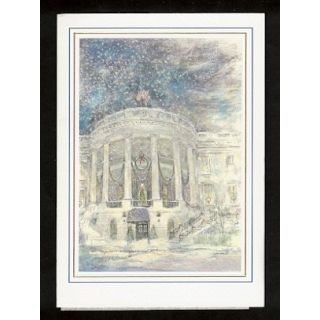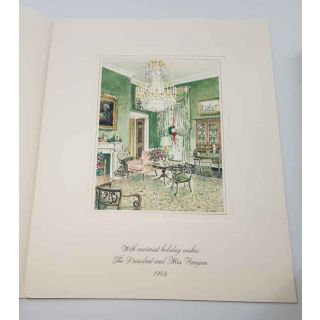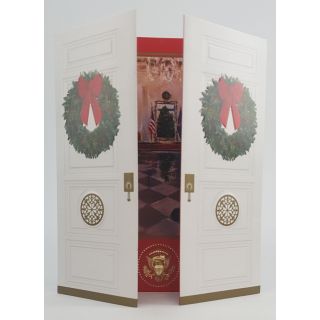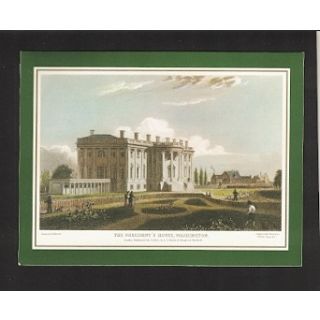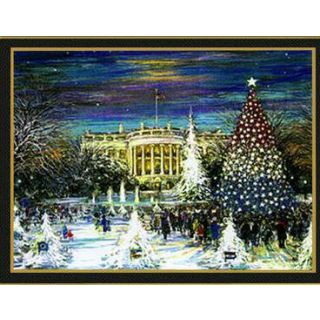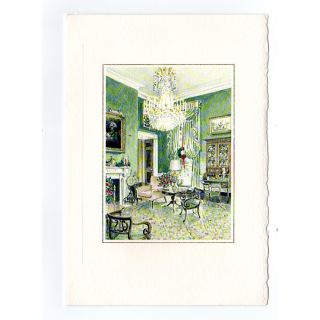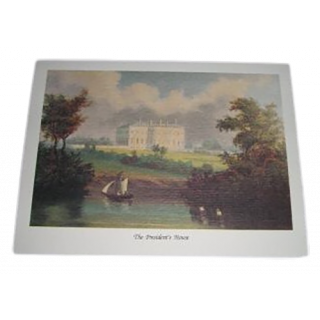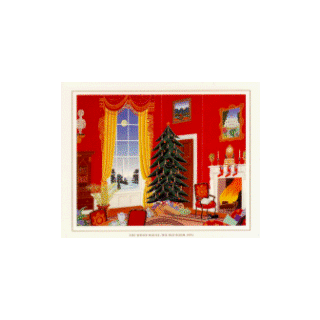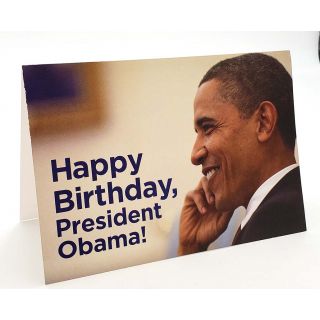White House Christmas Cards
Christmas Card Greetings From The White House
By: Robert Reed
|
|
It must be quite a thrill to actually receive a Christmas card from the President of the United States. For more than half a century there have been official greeting cards from the White House going out to a select number of people for the holidays.
The traditional practice has endured through bright days and dark days, through times of peace and times of conflict. Today the Christmas cards of presidents past are a significant area of holiday collectibles.
Historians do not fully agree on exactly when the custom began.
President Calvin Coolidge issued the first official Christmas message to the American people in the 1920s according to sources at the White House. Coolidge also participated in the first Christmas tree lighting ceremony at the White House. In 1923 the first event was known as the Pageant of Peace. Some sources say Coolidge was actually sending out a few Christmas greeting cards from the White House by 1927.
White House officials and most historians agree that President Herbert Hoover clearly was sending out holiday greetings from the executive residence by the early 1930s. In 1931 the president and Mrs. Hoover reproduced favorite family photographs for family, friends, and staff. As an added touch Hoover personalized the holiday greetings photographs with hand-written messages in the margins.
Franklin Delano Roosevelt introduced more of a stylized Christmas card in 1937 which was provided by the diistinguished Brewood Engravers. The single-sided FDR offering was a small, three by four inch, lithograph of a snow covered farm with two red barns and two green fir trees. The inscription said simply, "Christmas 1937." Basically the Christmas remain unchanged for the next several years except for updating the numbers of the year.
|
|
In 1942 the president and Mrs. Roosevelt departed from the basic Christmas card standard to return to the photograph style that Hoover had initiated. The Roosevelts appeared in a black and white image which depicted them sitting outside of the oval office at a drop-leaf table. The printed greeting on the card read:
"With Christmas Greetings and our Best Wishes for a Happier New Year."
The following year, as World War II raged on around the world, the Roosevelts selected a different photograph but the same type of greeting. In the 1943 version the couple was seated outside at a cloth-covered table. The photograph was taken by Ralph Short of Poughkeepsie, New York.
When President Harry Truman occupied the White House in the latter 1940s and early 1950s there were two sizes of Christmas greetings distributed on behalf of the family. The larger cards were reportedly given out on a much more limited basis, although both would be consider by collectors to be quite scarce today.
"Since the Truman era," notes one leading dealer of American political memorabilia, "both small and large cards have been given. The larger cards continue to be much rarer than the smaller cards."
In 1951 the president and Mrs. Truman used a Christmas card with a photograph of Blair House to send their traditional greetings. The first couple lived there from November of 1948 until March of 1951 while the White House was under extensive renovation.
It is generally acknowledged that the first official White House Christmas greetings card came under the administration of Dwight D. Eisenhower. Starting in 1953 "Ike" make the impressive Presidential Seal the dominate part of the White House card. The mailing list was expanded considerably to include members of the Cabinet, members of Congress, American ambassadors aboard, and foreign heads of state. That year 1,100 cards were dispatched. From that point on, according to authorities in the nation's capital, the official Presidential Holiday Greeting became the White House Christmas card.
President Eisenhower designated one of the nation's leading greeting card makers, Hallmark, to produce the first official card in 1953. Since that time Hallmark has produced more than 35 different White House greetings cards.
Throughout the remainder of the Eisenhower years the Presidential Seal was the single stark feature on the front of the cards. In 1955 the card included a blue silk screen background, and distribution increased to 1,300. The following year the Eisenhowers used a slightly more embossed seal but the basic format remained the same. Inside the text read:
"The President and Mrs. Eisenhower extend their best wishes for Christmas and the New Year."
In 1961 President John Kennedy also incorporated the dramatic Presidential Seal for the White House Christmas cards. The card used a smooth white stock with a bold green silk border, and used the words, "Season's Greetings 1961," on the front. Inside the card the president and Mrs. Kenney extended wishes for a "Blessed Christmas and a Happy New Year."
Coming at a tragic time in the nation's history the White House Christmas card in December 1963 was starkly white except for a thin red border at the bottom. Although the card was embossed by the Presidential Seal, the card contained no additional color and no holiday symbol. Two variations of two-word messages were used inside. One said "Blessed Christmas" while others read "Season's Greetings." Newly sworn-in president Lyndon Johnson and Mrs. Johnson actually sent the cards during the official mourning period following the November 22 assassination of President John Kennedy.
According to Mary Evans Seeley author of Season's Greetings From the White House, a memo from the United States Department's chief of protocol just five days after JFK's death prompted the Johnsons to continue the tradition despite the circumstances. In any event the list that holiday season was significantly limited and included a relatively few governmental leaders in the United States and abroad.
By 1967 the Johnsons had returned to more festive White House greeting cards. That year the cards included a reproduction of an interior painting of a Christmas tree in the Blue Room by artist Robert Laessig. The holiday cards were sent to 2,600 people.
President Richard Nixon and Mrs. Nixon found the idea of reproducing a vintage painting on White House cards appealing as well. In 1971 their selection was the reproduction of a 1930 painting by N.C. Wyeth. Originally the Wyeth work had been used as a patriotic poster commissioned by the Pennsylvania Railroad. The painting itself depicted President George Washington and architect James Hoban as they inspected the uncompleted White House in 1798.
A few years later in 1975 President Gerald Ford and Mrs. Ford selected a 1858 painting by George H. Durrie for the official White House greetings card. The painting, called Farmyard in Winter, was framed in red foil and represented what many considered to be an old-fashioned Christmas scene.
Some striking historical scenes were revised for the White House cards during the latter 1970s by President Jimmy Carter and Mrs. Carter. In 1978 they selected an 1877 hand-colored wood engraving of the White House to highlight the cards. Instead of Hallmark, the Carters selected American Greetings for the production of the greetings. No year appeared on the inside, just the message, "with best wishes from our family for a happy holiday season."
The Carters decided on a unique1860 sketch of the historic White House for the 1979 greeting cards. That particular year they were also produced by American Greetings.
In 1981 President Ronald Regan and Mrs. Regan chose a painting by artist Jamie Wyeth as focus of the annual cards. Appropriately the title of the original painting was Christmas Eve at the White House. The Hallmark-made card that year was issued in two sizes with the larger 11.5 by 12 inch version being sent to a much more limited and selective list. By 1986 the Regans had begun the use of the first of a series of paintings by Thomas William Jones for their official Christmas cards. Mrs. Regan showcased rooms not previously featured on White House cards including the East Room in 1986, the State Dining Room in 1987, and the North Entry Hall in 1988.
The first of the President George H. Bush's official greetings cards in 1989 featured a painting by William Gemmell. The title of the painting, Celebrating Christmas at the President's House, was included on the card's image. The White House cards that year were also issued in two sizes with the larger 12 by 16 inch version being the most restricted in number.
President William Clinton and Mrs. Clinton returned to the interior of the White House for their 1995 White House greetings cards. The White House Blue Room was rendered by artist Thomas McKnight who also provided the artwork for the cards the previous year and the year afterwards. In 1995 the following message appeared just above the facsimile signatures of Bill and Hillary Clinton:
"Our family wishes you and yours a beautiful holiday season filled with the warmth of friends and loved ones, and with the promise of a happy new year."
The Clintons welcomed "...joy and peace in new millennium" with their 1999 White House greetings card. The card depicted a snow covered North Portico of the White House based on a watercolor by Ray Ellis. The cards were mailed to an estimated 400,000 people.
President George W. Bush and Mrs. Bush picked a "cozy corner" for their 2001 official first family Christmas card. It featured attractively wrapped packages inside the second floor corridor of the White House. Hanging on the wall in the back of the image was a section of the painting Young Woman and Two Children by Mary Cassatt. The Bush holiday greetings card had a mailing of 875,000.
In 2002 the president and Mrs. Bush selected an oil painting of a 1938 Steinway grand piano in the Grand Foyer of the White House to 'decorate' their official card. This time the mailing reached an all-time presidential record of one million Christmas cards. And ironically the inscriptions on the cards had long since ceased the use of the word Christmas.
That year the New York Times estimated that the postage alone, a 37-cent American flag stamp on each, would reach $370,000. However in recent decades the enormous expense and effort of such mailings has been borne by the political party of the person who was in office at the time.
Back in 1982 the legendary Hallmark company donated its extraordinary Presidential Christmas Card collection to the National Museum of American History, a part of the Smithsonian Institution.
However many truly authentic White House greetings card remain. In 1998 a simple holiday card, an image of angels hovering over a creche in the East Room of the White House, sold at auction for $11,000. According to the Los Angeles Times it was one of 30 or so signed by John Kennedy and Jacqueline Kennedy before they left for Dallas in November of 1963.
Reprinted from "The Antique Shoppe" Florida's Antiques and Collectibles Newspaper
Click here to visit our collection of White House Christmas Cards and Programs available for sale




